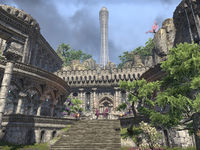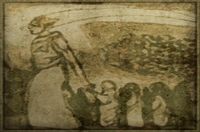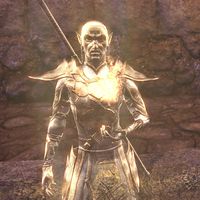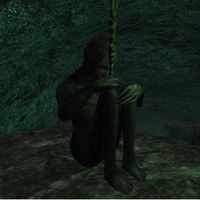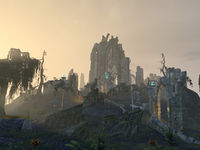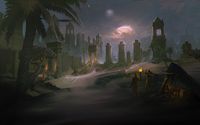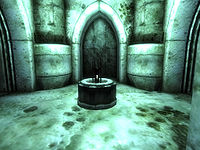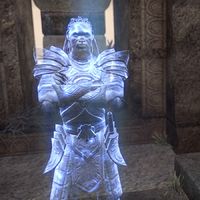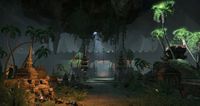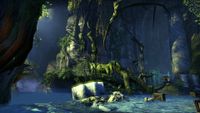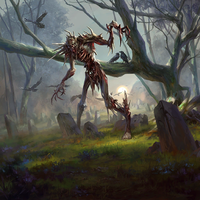Lore:Ancestor Worship
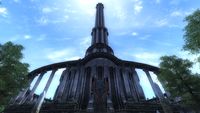
Ancestor worship refers to veneration of the dead based on respect for the deceased. Depending on the culture, it may involve praying to direct family or paying tribute to specific figures of historical importance. Direct communion with, or manifestation of, the dead to provide favors or advice is also a common element.[1]
Ancestor Worship is especially important to elves, many of whom believe themselves to be the direct descendants of et'Ada.[2][3] Some traditions even hold that gods are merely exceptionally powerful ancestor spirits.[4] The now common terms Aedra ("our ancestors") and Daedra ("not our ancestors"), were originally specifically used in this context.[5] Nevertheless, aspects of ancestor worship can be found in many cultures all across Nirn.
Altmer[edit]
The early Aldmer followed a strong tradition of ancestor worship, which they had brought with them from Aldmeris to Summerset.[6]
The Crystal Tower was constructed not to honor any king or god, but rather the spirit of the elven people, living and dead. It served both as a shrine for the ancestors and a graveyard for the early Aldmer settlers. This was seen as a fairly egalitarian time politically, as traditions of ancestor worship helped foster communal values.
However, as Aldmer society grew it also grew more stratified, social divisions became increasingly important. This social shift was reflected in Aldmer religion, as emphasis shifted away from worshipping one's own ancestors towards worshipping the ancestors of their "betters". The ancestor spirits of the upper castes grew in popularity, and in time, they were converted into gods. Where once Auri-El had been an ancestor spirit of the nobility, eventually, all the Altmer would claim Auri-El as a common ancestor.[6][2]
Other notable ancestor spirits who survived this shift toward godhood include Trinimac, Syrabane, Xarxes, and Phynaster, all of whom remain in the modern pantheon of the Altmer.[2]
A number of elders rebelled against this religious trend. They termed themselves the Keepers of the Old Ways of Aldmeris—also known as the Psijic Order—and used their collective powers to settle the island of Artaeum.[6] This Psijic Order held to the "Old Ways"; the ancient belief that all divine forces are driven by ancestor spirits. To them, even the Aedra and Daedra are just the spirits of exceptional mortals who attained power in the afterlife.[4] Soon after the Psijic schism, there was a mass exodus of the lower-classes from Summerset.[6]
Dunmer[edit]
—Ancestors and the Dunmer
One of the religious reformers who left Summerset in the wake of the Psijic schism was the Prophet Veloth.[6] His cult got its start in the years prior, reaching out to the downtrodden of Summerset and calling for a return to tradition. When the Sapiarchs outlawed his teachings, he eventually led his people from Summerset to modern-day Morrowind in an exodus that would later be known as "The Great Despair".[7][8] Veloth's Faithful were the Chimer, who would eventually become the Dunmer.[3]
Among his religious edicts was a return to ancestor worship. Veloth did not like how the Altmer had abandoned their ancestors, and wanted a return to the Old Ways, which he believed pure.[9][8] Like the Psijic Order, Veloth's faithful also believed that Daedra were merely powerful forebears, and he taught his people how to negotiate with them.[10][11][7]
Circa 1E 416, a champion of Azura named Indoril Nerevar united the Chimer people in the First Council. A follower of the Old Ways, Nerevar swore to honor the spirits the land, and his Great Ring of the Ancestors (also known as the Moon-and-Star) was blessed by Azura to serve as proof of his oath and identity.[12] Nerevar died during the Battle of Red Mountain around 1E 700. Soon after, three of his generals achieved apotheosis, and Azura cursed them and their followers to become the Dunmer.[13]
The exact circumstances of Nerevar's death, as well as the Tribunal's involvement, remained disputed for millennia. Regardless, Nerevar himself became recognized as an important ancestor spirit and religious figure by all sides of the schism.[12][14]
The Tribunal Temple[edit]
In 1E 700, with the advent of the Tribunal and the birth of the Dunmer, the people's relationship with ancestor worship was transformed. The divinity of ancestor spirits was de-emphasized, and Daedra were placed into a subservient role to the Tribunal. The good Daedra Boethiah, Mephala, and Azura were recast as the "anticipations" of Vivec, Almalexia, and Sotha Sil, respectively. Some of the more important ancestor spirits, including Veloth and Nerevar, were made into saints instead.[11][15]
Dunmer believe that their spirits persist after death, and are bound to their families. Marriage does tie one to their new family, but less strongly than blood—a spirit's blood family will always be able to access them. Family spirits sometimes manifest physically to grant boons or advice, but most hate doing so. They generally can't interact with objects physically, but some retain their magical expertise. When they manifest, they experience a painful phenomenon known as the Mortal Chill. The Mortal Chill often drives such spirits insane, and these "Mad Spirits" are purposefully employed as servants and guards by the Temple.[16][17]
In return for these boons, families are oath-bound to pay respect to their ancestors. To that end, in the times prior to the Blight, each family kept a family shrine—little more than a hearth, for poorer families—where family relics are venerated. This shrine is sometimes called The Waiting Door, representing the door to Oblivion. However, their ancestors' actual remains were ideally sent to a mausoleum known as a City of the Dead, the most famous being at Necrom. Sometimes, pieces of an ancestors remains were used to construct a family ghostfence—a magic wall that draws spiritual energy to itself to barricade family holdings.[16][18]
Dunmer have historically drawn a strong distinction between Necromancy and the "Spirit Magic" employed by the Tribunal Temple. Though both involve summoning and manipulating the undead, Spirit Magic is generally viewed as sacred, whereas Necromancy is perceived as impure.[19] Even then, there are exceptions. Prior to Morrowind entering the Empire, Telvanni Necromacy was considered perfectly acceptable, as long as their targets were animals or non-Dunmer. The Dunmer cultural view of necromancy was seen as hypocritical by many outside the Temple, and also served to elevate tensions with the Third Empire, where necromancy was legal.[16][19][20] Bonewalkers and Bonelords are a type of undead created through sacred ritual; the rituals used to create these undead are not considered to be necromancy in Morrowind.[20][16]
By 3E 427, with the return of Dagoth Ur and the coming of the Blight, Dunmer ancestor worship was forced to change yet again. By order of the Tribunal, the vast majority of all ancestors' remains were redirected to the great Ghostfence surrounding Red Mountain. The Temple began to decry previous traditions as selfish, and family shrines fell into disuse as no new people were allowed to be buried in them. Instead, local temples were permitted small amounts of each persons' remains, and their families were encouraged to worship there instead.[16][21]
After the defeat of Dagoth Ur, the Ghostfence's barrier was no longer necessary, and was deactivated. This signaled an end to the need for new remains, and the Ghostgate itself became a monument to the dead.[21][22] However, the impact on ancestor worship and family tombs is uncertain, as the disappearance of the Tribunal may have led to the rise of other factions such as the Imperial Cult.[23]
Some House Dunmer carried an ancestral urn and a folding altar with them on their travels to worship abroad. These urns were often quite fancy, with some being made of pewter with gold filigree.[24]
Ashlander Tribes[edit]
Not all Dunmer would accept the Tribunal's reforms. Even after the emergence of the Tribunal Temple, tribal Ashlanders continued to hold to the Old Ways of ancestor worship. For this, they were initially perceived by both House Dunmer and outlanders alike as barbaric and shamanistic.[25][26]
Though Ashlanders recognized Nerevar as a House Dunmer, he was still revered for honoring the Ancient Spirits and preserving Tribal Law.[14][12] After his death at the battle at Red Mountain, Nerevar’s shield-companion, Alandro Sul, accused the Tribunal of orchestrating his murder and achieving apotheosis through necromancy. Following his teachings, the Ashlander tribes rejected the Tribunal’s religious reforms and subsequently faced millennia of persecution from the Temple.[25][27]
Ashlander religious traditions bear some broad similarities with Temple Ancestor Worship. For example, Ashlanders believe the spirits of the strong persist after death and beseech them for wisdom. Ashlanders also maintained ancestral burial grounds, which they continued to use even as the practice declined among House Dunmer due to the Ghostfence.[28] Unlike the Temple however, Ashlanders never purposefully employ Mad Spirits as guards or servants, instead fearing them as ghosts, devils, and daemons.[10] Additionally, they believe that any manipulation of the bodies or spirits of ancestors is necromancy, and therefore that the Spirit Magic of the temple is an abomination.[19] Unlike House Dunmer, the Ashlanders often mummify their dead using ash salts.[29]
Each tribe is said to maintain a tribe-specific Ancestor Cult, which venerates the heroes and leaders of their own tribe above other ancestors. A tribe's religious rites are led by a female shaman known as a Wise Woman who, in addition to communion with ancestor spirits, is also charged with preserving a tribe's oral history.[10][26] Some Wise Women have additional unofficial duties from placating angry spirits to counseling Ashkhan, or even leading in their abscence.[30]
All Ashlanders venerate Nerevar as an ancestor and pass down some of his prophecies, but the Urshilaku Tribe in particular is noteworthy for hosting the Nerevarine Cult.[31] The Nerevarine Cult believed that a reincarnation of Nerevar would return to cast down the Tribunal Temple, cast out the foreigners, and restore Morrowind to the Old Ways of ancestor worship.[20][14] Those who attempted, but failed, to fulfill all seven prophecies related to the return of Nerevar were known as "false incarnates", and their spirits are venerated in the Cavern of the Incarnate. In 3E 427, Nibani Maesa, then-Wise Woman of the Urshilaku, helped the Nerevarine achieve recognition as the true reincarnation of Nerevar.[32][33]
Dissident Priests & the New Temple[edit]
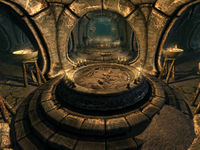
A faction from within the temple known as the Dissident Priests took to recording Ashlander religious practices and oral history—including the Nerevarine prophecies. The Dissident Priests questioned the divinity of the Tribunal and historicity of the Temple's official narrative of the Battle of Red Moutain. Many saw studying Ashlander teachings as one way to pursue the truth.[34][35][36]
The Temple official position was that Ashlander beliefs were heretical, with supression of the Nerevarine Prophecies receiving special attention.[36] For this reason, the Dissident Priests too were persecuted for recording and studying the Nerevarine Prophecies. The Temple's justification was that dissent from within the clergy weakened the people's faith and therefore the Tribunal's efforts to combat Dagoth Ur.[36][35] However, following the return of the Nerevarine, this official persecution came to an end by order of Vivec.[27]
Like the Ashlanders, Dissident Priests called for a return to the Old Ways of ancestor worship. Unlike the Ashlanders however, the Dissident Priests still had a fundamentally positive view of the Tribunal. Though they called for reform in how the Temple employed force, they still believed that the Tribunal and the core of Temple doctrine was fundamentally good.[34]
In 4E 5, following the devastation of the Red Year, the Temple and Dunmer society as a whole entered a period of reorganization. While most of the records from the transition period are lost, by 4E 201, the Dissident Priests had formed the New Temple. As the Old Temple had once done to Veloth, the Tribunal were demoted to saints, and the temple once again returned to the Old Ways of ancestor worship. By this time, the use of family shrines and ancestral tombs appeared to once more be commonplace.[37] The New Temple no longer persecuted Ashlanders, instead praising them for having the "true vision" to continue practicing the Old Ways. Adherents of the New Temple often make pilgrimage to seek the wisdom of an Ashlander Wise Woman.[38]
Despite the majority of the Dunmer people turning away from Tribunal worship, Almsivi were still revered as gods by certain sects. These devotees were regarded as heretics by the New Temple and were persecuted for their beliefs.[39] One cult of Almalexia worshippers constructed a hidden temple to the Tribunal in a cave on Solstheim known as Ashfall's Tear, just north of Raven Rock. The cultists raised a giant statue to the Goddess Almalexia and planned to use old propaganda to restore widespread Tribunal worship.[40][41] Circa 4E 201, the Last Dragonborn was alerted to the cult's existence, although it is unknown if the Dragonborn aided the cult or destroyed it.[40]
Ayleid[edit]
Ayleids were known to place a great deal of spiritual importance in their ancestors.[42] Chief among those were the Ten Ancestors, famously represented as ten statues wrought from meteoric glass and iron. The White-Gold Tower, which the Ayleids called the Temple of the Ancestors, was constructed in-part to house these statues.[43]
Veneration of the Ten Ancestors was historically a key part of Ayleid religion. They were so culturally ubiquitous that it even became traditional to structure books in 10 chapters to honor them.[44] Even following the Narfinsel Schism,[45] which split Ayleid religion along Aedra-Worshipping (Barsaebic) and Daedra-worshipping (Daedraphile) lines, ancestor worship appeared to remain important to both sides of the conflict. The Daedraphiles continued to venerate the Ten Ancestors, but now held that the ancestors had likewise been Daedra worshippers. Holy texts, such as The Eleven Edicts of the Ten Ancestors, were written to reflect this.[46] For their part, even as they fled into Black Marsh, the Barsaebics also maintained their ancestor worship. Loriasel in Shadowfen was built by the Barsaebics as a temple to venerate the Ten Ancestors.[42]
The Heretic of Lindai authored The Eleven OTHER Edicts of the Ten Ancestors—a parody of the Eleven Edicts which asserted, among other things, that the Ten Ancestors had worshipped Auri-El.[46]
Worship of the Ten Ancestors declined with the Ayleids. When the Alessian Slave Rebellion began, the statues were hastily removed from the White-Gold Tower and sent to various Ayleid kingdoms for safekeeping. The statues would not be reunited again until 3E 433, when the Altmer scholar Umbacano located them with help from the Hero of Kvatch[47]
Redguard[edit]
—The Improved Emperor's Guide to Tamriel
The origins of Redguard Ancestor Worship is unclear. Some believe this ancient tradition began after the Yokudans settled in Hammerfell. They noticed that corpses decomposed very slowly in the desert, and over time the people assigned a spiritual significance to the process and declared that the remains of their ancestors were sacred.[48] Other sources claim Ancestor Worship was the most sacred law and tradition of the ancient Yokudans.[49]
Redguards are famous not just for their many religious rituals surrounding the dead, but also for the elaborate necropolises they build to house them. At these sacred sites, supplicants give prayer not just to their own direct ancestors, but also historical Redguard kings and the untold number of Yokudans who perished when the continent sank.[50]
In addition to performing continuing rites for dead ancestors in general, Redguards also specifically honor the spirits of Sword-Singers. Multiple temples (perhaps most notably Tu'whacca's Throne) host the spirits of departed Ansei who remain to pass on their wisdom to supplicants. Religious rites, such as the Trials of the Hero, are used to contact them and gain their favor.[51] Some Ansei have become associated with gods, such as Frandar Hunding who is often referenced together with HoonDing, the make-way god.[52][53][54]
Redguards are especially disgusted by necromancy, which they see as profaning the honored dead. As bringing any harm to the honored ancestors is considered sacrilege, many Redguard warriors refuse to even defend themselves against undead.[48] A set of holy artifacts known as the Ansei Wards is meant to protect consecrated dead in the Alik'r from necromantic rituals. Even so, multiple necromancers and even the Imperial Legion have been able to leverage the Redguards' unwillingness to hurt the undead to their own advantage.[55][50]
A secretive tribe of pariahs known as the Ash'abah are dedicated to the taboo task of purifying angry ancestor-sprits and saving Hammerfell from necromancers.[50] Ash'abah methods of slaying the undead often involve repeated ritual apology, so as not to disrespect the ancestors.[56] Despite their service being widely considered necessary, the tribe is still reviled by the wider Redguard society for hurting the undead. Even the act of speaking to an Ash'abah is treated as profaning oneself.[48]
Other Traditions[edit]
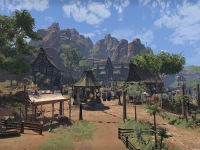
The Nords honor their ancestors and place offerings in or at their graves. Apples, wine, gold coins or snowberries are often offered to the ancestors.[57]
Like the Redguards, the desert-dwelling Khajiit were also once known for their massive necropolises where they would give offerings and prayer to their ancestors.[58] Some adeptoriums also communed with ancestor spirits for advice. However, this kind of ancestor veneration had largely died out in Elsweyr by the mid-Second Era.[59] Even popular culture heroes like Khunzar-ri found their tombs falling into disrepair.[60]
On the last day of every year, Imperials observe the Old Life Festival, a holiday about giving offerings and passing messages to ancestors and dead loved ones.[61]
Hakoshae, a community of Imperials claiming Akaviri descent, maintained what they believed was the Tsaesci tradition of ancestor worship. In 2E 582, they revived the Proving Festival—an Akaviri holiday where supplicants prove their wisdom, strength, and honor to their ancestors.[62][63]
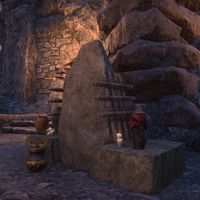
An Orcish religious order known as The Wrathful Flame performed a decennial pyre-burning ritual in the ruins of Old Orsinium for a time. They communed with Malacath by giving praise to and cursing the ancestral clans of Orsinium, symbolically keeping their desire for vengeance alive through generations of their descendants. In 2E 582, the ritual was interrupted when their members were killed by Reachmen. The Soulless One completed this ritual, but it is unknown what became of the order in subsequent years.[64]
The Reachmen have a class of story-tellers called vateshran. Their job, among other things, is to ritualistically commemorate the dead ancestors of the clan through song.[65] Reachfolk honor their ancestors by living the life the way they did and believe that their ancestors observe them from the sky above and await reunion during which the stories of the battles their descendants fought will be exchanged.[66] Some of the clans ritually sacrifice animals as a form of offering to the ghosts of venerated ancestors and ancient heroes.[67]
The Spiritblood Clan have their children undergo dangerous trials (called the Vateshran's Rites) as a rite of passage. Those who emerge become fully-fledged members of the clan, and earn a vateshran song that will last forever.[65] The Lamenter of the Slain, one of the proctors of the trial grounds, performs rites on behalf of all who have died during their Vateshran's Rites. Warriors of the Spiritblood who fell defending the ways of their ancestors are honored by having Totems of the Brave erected in their honor.[68] One ancestor spirit in particular—Aydolan, the clan's first Vateshran—personally guides prospective challengers.[69] One of the many other clans of the Reach believe that their ancestors bring them messages through one specific breed of snowy bunnies.[70]
One theory about why minotaurs gather around Alessian ruins is that protecting them is a form of veneration for Belharza (or Morihaus, Alessia, etc.).[71][72]
The Psijic Order have declared centaurs "true followers of the old ways", referring to the complex system of ancestor worship that Artaeum itself espouses.[73]
Ancestor worship was a focal point in Breton religion from antiquity. The Daggerfall holiday known as the Day of the Dead is believed to come from this.[74]
The Elders of Bramblebreach are the ancestor spirits of the modern-day Bramblebreach Clan. Though they are largely seen as a child's tale, they are considered one with the Wilderking Court and provide wisdom when needed.[75][76]
Gallery[edit]
See Also[edit]
References[edit]
- ^ Events of Divine Conundrum in ESO
- ^ a b c Varieties of Faith — Brother Mikhael Karkuxor of the Imperial College
- ^ a b The Changed Ones
- ^ a b The Old Ways — Celarus the Loremaster
- ^ Aedra and Daedra
- ^ a b c d e Pocket Guide to the Empire, 3rd Edition: The Blessed Isle: Alinor and the Summersets — Imperial Geographical Society, 3E 432
- ^ a b Daedra Worship: The Chimer — Phrastus of Elinhir
- ^ a b Exodus from Summerset
- ^ Generic dialogue regarding Altmer in Morrowind
- ^ a b c Generic dialogue regarding Ancestors in Morrowind
- ^ a b Veloth the Pilgrim — Cascius the Proud
- ^ a b c Nerevar Moon-and-Star
- ^ Nerevar at Red Mountain — the Tribunal Temple
- ^ a b c Generic dialogue regarding the Nerevar in Morrowind
- ^ The Anticipations — Anonymous
- ^ a b c d e Ancestors and the Dunmer
- ^ Mavos Siloreth's dialogue in ESO
- ^ The Waiting Door — Canon Nileno Nirith
- ^ a b c Generic dialogue regarding Necromancy in Morrowind
- ^ a b c Sharn gra-Muzgob's dialogue in Morrowind
- ^ a b Generic dialogue regarding the Ghostfence in Morrowind
- ^ Generic dialogue regarding the Ghostgate in Morrowind
- ^ Avrus Adas' dialogue in Oblivion
- ^ Filigreed Ash Urn with Portable Altar item description in ESO
- ^ a b Generic dialogue regarding Ashlander Culture in Morrowind
- ^ a b Generic dialogue regarding the Ashlanders in Morrowind
- ^ a b Vivec's dialogue in Morrowind
- ^ Meet Sul-Matuul quest in Morrowind
- ^ Urshilaku Burial Caverns in Morrowind
- ^ The Trial of the Ghost Snake quest in Online
- ^ Caius Cosades's dialogue in Morrowind
- ^ Nibani Maesa's dialogue in Morrowind
- ^ The Path of the Incarnate quest in Morrowind
- ^ a b Progress of Truth — Dissident Priests
- ^ a b Generic dialogue regarding the Dissident Priests in Morrowind
- ^ a b c Mehra Milo's dialogue in Morrowind
- ^ Elder Othreloth's dialogue in Dragonborn
- ^ The Reclamations — Thara of Rihad
- ^ Heretic Dossier: Blacksmith's Confessional
- ^ a b Ghosts of the Tribunal quest in Skyrim
- ^ Her Word Against Theirs quest in Skyrim
- ^ a b Loriasel loading screen in ESO
- ^ Umbacano's dialogue in Oblivion
- ^ A Life of Strife and Struggle — King Laloriaran Dynar
- ^ Ayleid Survivals in Valenwood — Cuinur of Cloudrest, 4th Tier Scholar of Tamrielic Minutiae
- ^ a b The Library of Dusk: Rare Books
- ^ The Collector quest in Oblivion
- ^ a b c King Fahara'jad's dialogue in ESO
- ^ Vizier Yeqdah's dialogue in ESO
- ^ a b c EGT — Flaccus Terentius, 2E 581
- ^ Revered Ancestors quest in ESO
- ^ Varieties of Faith, Crown Redguards — Brother Mikhael Karkuxor of the Imperial College
- ^ Hoonding's Prayer Stone contraband item in ESO
- ^ Hoonding's Golden Quill contraband item in ESO
- ^ Sacrilege and Mayhem in the Alik'r — Doctor Tazhim of the Bureau of Outlander Affairs
- ^ Correct Ways of Slaying Ra-Netu: 12
- ^ Offerings in Hillgrund's Tomb in Skyrim
- ^ Relatively Speaking quest in ESO
- ^ Jora-ri's dialogue in ESO
- ^ Khunzar-ri's dialogue in ESO
- ^ Petronius Galenus's dialogue during Old Life Observance in ESO
- ^ Magnate Feina-Darak's dialogue in ESO
- ^ Descendant of the Potentate quest in ESO
- ^ Flames of Forge and Fallen quest in ESO
- ^ a b The Rites Matron's dialogue in ESO
- ^ Ardanir's dialogue in ESO
- ^ Great Spirits of the Reach: Volume 2 — Vashu gra-Morga, Chief Daedrotheologist at the University of Gwylim
- ^ Lamenter of the Slain's dialogue in ESO
- ^ Vateshran's Rites quest in ESO
- ^ Powderwhite Coney's description in ESO
- ^ On Minotaurs — Nonus Caprenius, Temporarily Unaffiliated Scholar of Imperial Antiquities
- ^ The Minotaur Song
- ^ Daggerfall User's Guide
- ^ Holidays of the Iliac Bay — Theth-i
- ^ Elders of Bramblebreach
- ^ Doriel's dialogue in ESO
|
|||||||||||||||||
